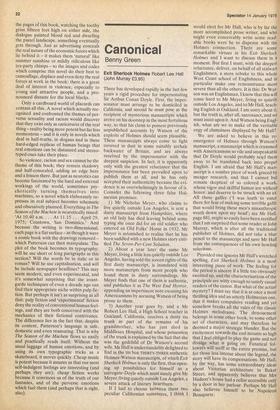Placards
Peter Ackroyd
The Season of the Machete James Patterson (Secker and Warburg £4.50) James Patterson spends his days as an advertising copywriter, in other words as a kind of American saint, and his novels reflect that fact. The Season of the Machete is set in San Dominica, which must itself be a television advertisement since 'we had learned before we ever saw the Caribbean that beautiful scenery provides the most chilling background for any kind of terrorism.' It is also used as a background for Gordon's gin and Timex watches, and it's nice to see that violence has now joined the list of consumer items. The quote is taken from the diary of Carrie Rose, one of two assassins who arrive in San Dominica and begin a wave of machete killings which gives the novel its bad name.
Each thing here is a fantasy. Tourists are like 'walking advertisements' until they are hacked to death; one couple actually regret their presence in reality — 'Remember the TV ads for this place?' — before they, too, are dismembered. The heroine of the book, an American girl who has her head blown away in a moment of crisis, has also been invented in Madison Avenue: 'she looks like the blonde beauty you always see at the beaches, but nobody ever seems to get.' And she even talks like an advertising campaign: 'Oh. . . hush, puppy.' These are the little things which people say to each other just before they meet bloody and violent deaths, and if I didn't know better I'd assume that Mr Patterson was taking vicarious vengeance on every resort he's had to hype, on every model into whose dumb mouth he's had to force some dialogue, and on every empty phrase/ which has ever gone whizzing from his Olivetti into someone's empty head.
But I do know better, and he isn't doing it deliberately. Everything is really as shallow as it seems; when his characters are not learning how to behave by reading advertising slogans, they ape film-stars and act as if they were in front of cameras; even their memories are `Kodachrome-colour'. They are, in other words, replicas of human beings, representations of the thing and not the thing itself. When photography succeeded painting, portraiture might have died; when replica-people succeed real people, the realistic novel certainly will. Of course it does mean that Mr Patterson needn't have any qualms about slaughtering them at a moment's notice; when characters are infinitely reproducible, they can be left on the cutting room floor.
But advertising can also work subliminally: if you drive at high speed through the pages of this book, watching the toothy grins fifteen feet high on either side, the dialogue painted blood red and dwarfing the pastel landscape, something eventually gets through. Just as advertising conceals the real nature of the economic forces which lie behind it — it makes them 'natural' like summer sunshine or mildly ridiculous like tea-party chimps — so the images and codes which comprise this novel do their best to camouflage, displace and even deny the real forces at work in the book: there is a great deal of interest in violence; especially to young and attractive people, and a pro nounced distaste for the local blacks. .
Only a cardboard world of placards can contain all this. A novel which actually recognised and confronted the themes of perverse sexuality and racism would discover that they exist only as caricatures of the real thing — reality being more potent but far less momentous — and it is only in novels which deal in half-truths, in slogans and in these hard-edged replicas of human beings that real emotions can be distanced and stereotyped ones take their place.
So violence, racism and sex cannot be the theme of this book; they remain shadowy and half-concealed, adding an edge here and a frisson there. But just as neurotics can become fascinated by the hard and external workings of the world, sometimes psychotically turning themselves into machines, so a novel which elaborately represses its real subject becomes schematic and obsessively planned. Everything in The Season of the Machete is neurotically timed: 'At 10.40 a.m. . . . At 11.15 . . . April 29, 1975; Coastown, San Dominica.' And because the writing is two-dimensional, each page is a flat surface — as though it were a comic book with the drawings removed — which Patterson can then manipulate. The plot of the book becomes its typography: will he use short or long paragraphs in this section? Will the words be in italic or in roman? Will he use capitalisation, and will he include newspaper headlines? This may seem modern, and even experimental, and it's somewhat surprising that the avant garde techniques of even a decade ago can find their appropriate niche within pulp fiction. But perhaps it isn't as surprising as all that: pulp fiction and 'experimental' fiction deny the reality of conventional human feelings, and they are both concerned with the mechanics of their fictional contrivance.
The difference lies in the fact that, despite its content, Patterson's language is safe, domestic and even reassuring. That is why The Season of the Machete flows so easily and practically reads itself. Without the
usual luggage of human emotions; and by
using its own typographic tricks as a skateboard, it moves quickly. Cheap music is potent because it assures us that our most self-indulgent feelings are interesting (and perhaps they are); cheap fiction works because it convinces us of the truth of our fantasies, and of the perverse emotions which fuel them (and perhaps that is right,































 Previous page
Previous page